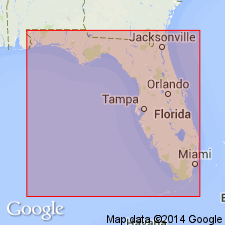
- Usage in publication:
-
- Suwannee limestone*
- Modifications:
-
- Named
- Dominant lithology:
-
- Limestone
- AAPG geologic province:
-
- Florida platform
Summary:
Name Suwannee limestone is proposed for yellowish limestone typically exposed along Suwannee River in FL, from Ellaville, where it unconformably overlies white limestone containing Vicksburg (Oligocene) fossils, almost to White Springs, near which it lies unconformably below Hawthorn formation (Miocene). Another large area of the limestone, centering near Brooksville, Hernando Co., lies between Ocala limestone (Eocene) on the north, and Tampa limestone (Miocene) on the south. Most writers have regarded this limestone as part of Tampa limestone and think it is of late Vicksburg age. They correlate it tentatively with Flint River formation of GA and Chickasawhay marl member of Byram marl of MS.
Source: GNU records (USGS DDS-6; Reston GNULEX).
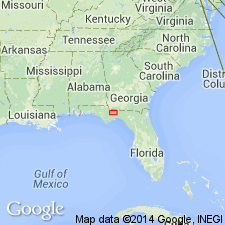
- Usage in publication:
-
- Suwannee Limestone
- Modifications:
-
- Overview
- AAPG geologic province:
-
- South Georgia sedimentary province
Summary:
Suwannee Limestone underlies most of FL with the exception of the northern and eastern portions of the peninsula. Typical Suwannee lithology is a white to cream to light olive gray colored fossiliferous micritic to crystalline limestone, frequently containing brown dolomite and minor sand. Mollusks and benthonic Foraminifera are common. Unconformably underlies early Miocene St. Marks and Chattahoochee Formations. Overlies Ocala Limestone. Thickness varies from 19 to 480 ft in subsurface of study area. Age is early Oligocene.
Source: GNU records (USGS DDS-6; Reston GNULEX).

- Usage in publication:
-
- Suwannee Limestone
- Modifications:
-
- Revised
- AAPG geologic province:
-
- Florida platform
Summary:
Bass 1 Core (W-10480, Florida Geological Survey) has been designated the hypostratotype of the Suwannee Limestone by Huddlestun (in press). Suwannee occupies upper 175 ft, while interval from 175 ft to 192 ft is named the Suwannacoochee Dolomite and interval between 192 ft and 204 ft is named the Ellaville Limestone. Core from Ellaville, generally considered the type locality of the Suwannee, has been divided by Huddlestun into Suwannacoochee Dolomite (from 18 ft to 23 ft 6 in.) and Ellaville Limestone (from 25 ft to 39 ft). Author of this report places lower boundary of Ellaville at 59 ft. Undifferentiated post-Oligocene siliciclastics occupy the interval above 18 ft. Alum Bluff 1 Core (W-6901) from Liberty Co. has been divided by Huddlestun into the Okapilco Member of the Suwannee (from 287 to 357 ft) and the Wolf Pit Dolomite (from 357 ft to 371.5 ft).
Source: GNU records (USGS DDS-6; Reston GNULEX).
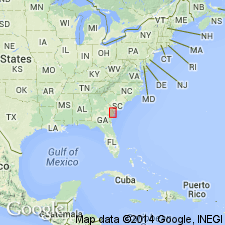
- Usage in publication:
-
- Suwannee Limestone
- Modifications:
-
- Principal reference
- Revised
- AAPG geologic province:
-
- Florida platform
- South Georgia sedimentary province
Summary:
Suwannee Limestone is revised and redefined in this report. It is the author's contention that the section exposed in the bluffs along the Suwannee River at Ellaville, originally included in the type area of the Suwannee Limestone by Cooke and Mansfield (1936), contains no Suwannee Limestone in the strict sense of the name. Beds 1 and 2 of Cooke (1945) described at Ellaville are here named the Ellaville Limestone while beds 3 and 4 are here named the Suwannacoochee Dolomite. A principal reference section (lectostratotype) for the Suwannee is designated at a bend in the river in Suwannee River State Park, approximately 1.5 mi northeast of Ellaville. Here the Suwannee consists of 16 ft (4.9 m) of very pale orange, massive-bedded and structureless to rudely and vaguely stratified and thick-bedded, mealy textured, soft to weakly indurated and friable, sparsely macrofossiliferous limestone. The Florida Geological Survey core Bass 1 (W-10480) near the center of sec 206, T3N, R10E, Madison Co., is designated a reference locality and hypostratotype. The limestone occurs in the interval between 23 ft and 175 ft. Thickness averages about 100 ft (30 m) over most of the central coastal plain of GA, but thins to an average 50 ft in the eastern part. The Suwannee underlies most of the coastal plain of southeastern GA. It is absent in the Gulf Trough and south of Glynn Co. along the coast of GA and eastern FL, but forms a broad northeast-southwest band from Savannah River to the Gulf of Mexico [now called Gulf of America]. Overlies the Suwannacoochee Dolostone at the type locality, the Bridgeboro Limestone (new) east and north of the Gulf Trough in GA, and elsewhere in GA, disconformably overlies the Ocala Limestone. Generally disconformably underlies the Parachucla Formation in GA, but locally disconformably underlies the Chattahoochee Formation or the Altamaha Formation. Grades laterally eastward in coastal GA into the Lazaretto Creek Formation (new) and into the Ochlockonee Formation on the flanks of the Gulf Trough. Age is early Oligocene (Vicksburgian, Rupelian) based on macrofossils, stratigraphic position, and correlation with the Byram Formation.
[Gulf of Mexico renamed Gulf of America (U.S. Board on Geographic Names per Presidential Executive Order 14172, issued January 20, 2025, and Department of Interior's Secretarial Order 3423, issued Feb. 7, 2025).]
Source: GNU records (USGS DDS-6; Reston GNULEX).
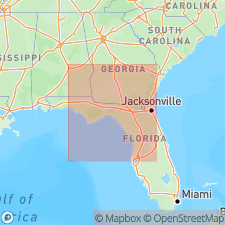
- Usage in publication:
-
- Suwannee Limestone
- Modifications:
-
- Geochronologic dating
- AAPG geologic province:
-
- Florida platform
Summary:
Authors use 87Sr/86Sr isotopic analyses in an attempt to resolve age relations of fossiliferous marine units that contain the remains of terrestrial vertebrates. Oldest samples are from the Suwannee Limestone. When age estimates calculated from the appropriate regression equations are averaged together, they yield a mean age of 34.8 Ma (early Oligocene). According to table 1, ages range from 35.5 to 33.6.
Source: GNU records (USGS DDS-6; Reston GNULEX).
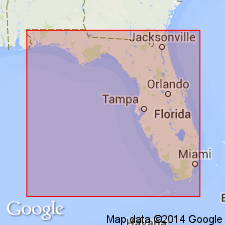
- Usage in publication:
-
- Suwannee Limestone
- Modifications:
-
- Overview
- Areal extent
- AAPG geologic province:
-
- Florida platform
Summary:
Unit occurs in two separate areas. In the northern peninsula it is very thin and mostly an outcropping formation. In the southern peninsula, it is a subsurface formation of white, skeletal packstone or grainstone, with occasional micrites. Underlies phosphatic limestone of Oligocene age assigned by this author to the Arcadia Formation. Lower contact with Ocala or Avon Park is difficult to distinguish in well cuttings as lithology is similar and no fauna are present. Strata referred to Suwannee by Bermes (1958) and Lichtler (1960) in St. Lucie and Martin Cos. are here referred to Arcadia Formation, based on data from newly-drilled wells. Author suggests that contrary to popular belief, no major unconformities from tectonic activity exist in south FL and the boundaries between the Ocala and the under- and overlying units are simple facies changes. In southeastern FL, where the Ocala appears to be missing, the Avon Park lithology merges directly into the overlying Suwannee.
Source: GNU records (USGS DDS-6; Reston GNULEX).
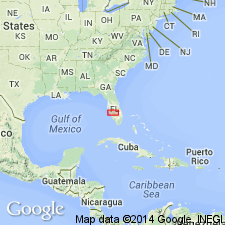
- Usage in publication:
-
- "Suwannee" Limestone*
- Modifications:
-
- Revised
- Age modified
- Geochronologic dating
- AAPG geologic province:
-
- Florida platform
Summary:
Following the usage of Scott (1988, The lithostratigraphy of the Hawthorn Group (Miocene) of Florida: Florida Geological Survey Bulletin 59, 148 p.), Suwannee is used with uncertainty as "Suwannee" Limestone. Historically, Suwannee has been placed in early, late, or entire Oligocene. Confusion as to age exists to this day and Scott (1988) believes that what has been commonly identified as Suwannee in report study area may not be correlative with Suwannee in its type area. Age is early Oligocene for "Suwannee" based on 87Sr/86Sr age estimates. Both an early Oligocene strontium date and an early Oligocene TURRITELLA were found a few meters above top of "Suwannee" in the Arcadia Formation.
Source: GNU records (USGS DDS-6; Reston GNULEX).
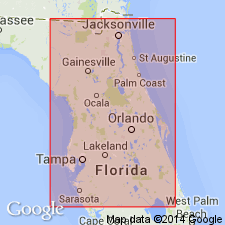
- Usage in publication:
-
- Suwannee Limestone*
- Modifications:
-
- Age modified
- Revised
- AAPG geologic province:
-
- Florida platform
- South Georgia sedimentary province
Summary:
Historically, all Oligocene sediments on FL peninsula were called Suwannee Limestone, a usage not in accordance with North American Stratigraphic Code. The majority of available age data (dinocysts, mollusks, and Sr/Sr isotope dates) indicate the Suwannee in subsurface of southern peninsular Florida is early Oligocene; no data are available that suggest a late Oligocene age for even a portion of Suwannee. This is in agreement with accepted age for Suwannee in its type area in northern FL and in its outcrop area in west-central FL. Rocks previously called upper Oligocene "Suwannee" Limestone on COSUNA chart (Braunstein and others, 1988) and by others in southern FL are hereby included in lower Oligocene Suwannee Limestone. Suwannee is overlain by lower to upper Oligocene Arcadia Formation.
Source: GNU records (USGS DDS-6; Reston GNULEX).
For more information, please contact Nancy Stamm, Geologic Names Committee Secretary.
Asterisk (*) indicates published by U.S. Geological Survey authors.
"No current usage" (†) implies that a name has been abandoned or has fallen into disuse. Former usage and, if known, replacement name given in parentheses ( ).
Slash (/) indicates name conflicts with nomenclatural guidelines (CSN, 1933; ACSN, 1961, 1970; NACSN, 1983, 2005, 2021). May be explained within brackets ([ ]).

